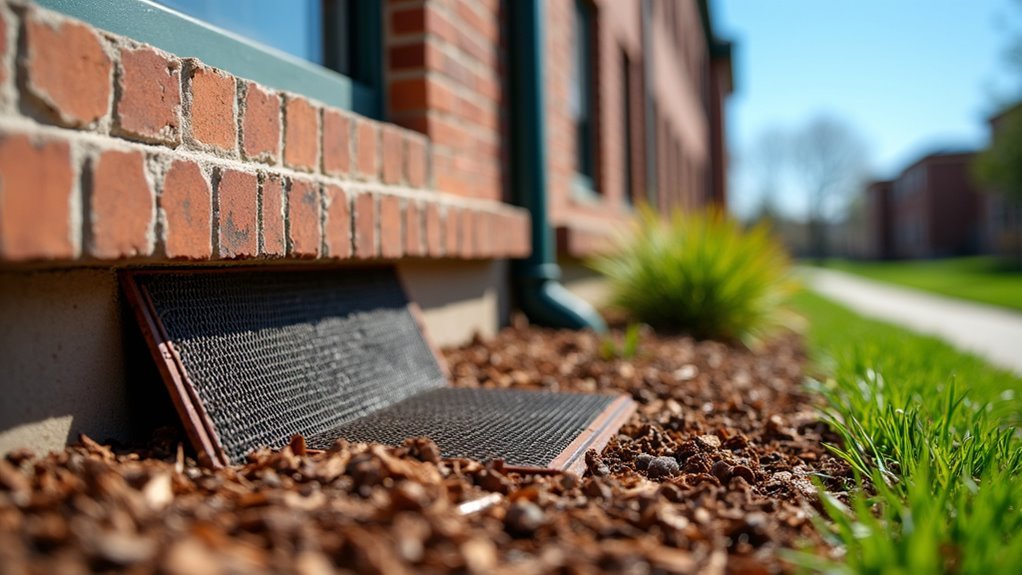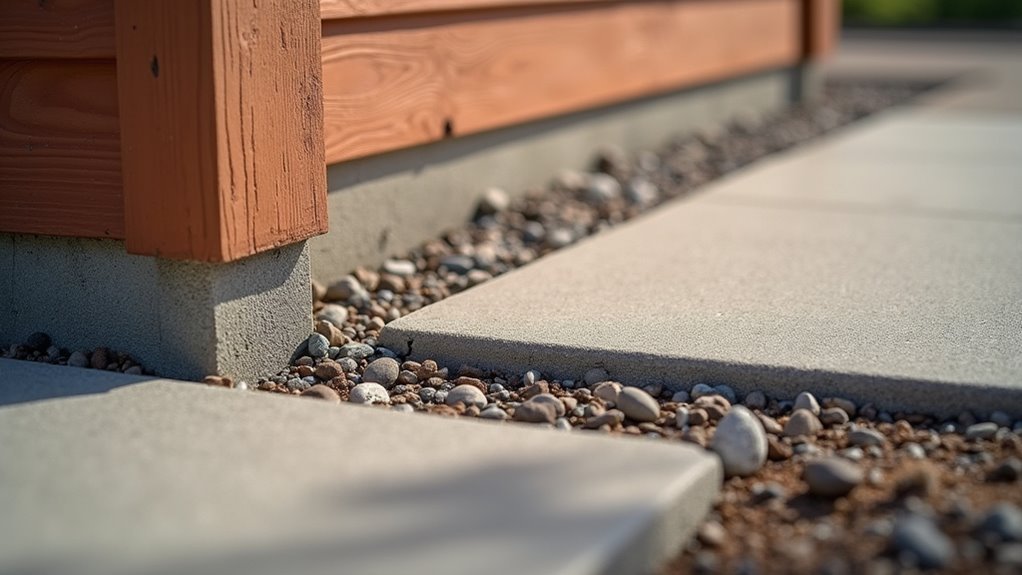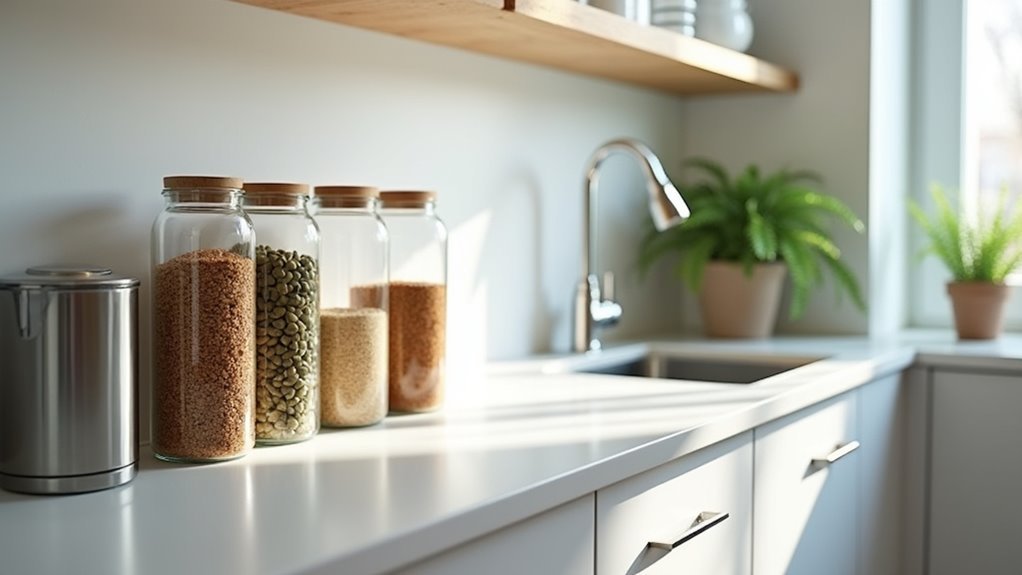You can create effective apartment pest barriers by establishing perimeter treatments three feet from your building’s foundation, sealing cracks around doors and windows with weather stripping and caulking, and controlling moisture sources that attract termites and cockroaches. Store food in airtight containers, maintain clean kitchens, and position trash bins away from exterior walls with tight-fitting lids. Combining these defensive layers with natural repellents and professional spray applications will help you discover thorough protection strategies.
Understanding Perimeter Pest Control for Apartment Buildings

When you’re dealing with pest problems in apartment buildings, perimeter pest control creates a defensive shield that stops unwanted invaders before they reach your living spaces. This approach works by establishing treatments that extend three feet up and three feet out from your building’s foundation to create a barrier against common pests like ants, spiders, and rodents.
Professional pest control services focus on identifying and sealing potential entry points while applying targeted products around shared areas, foundations, and landscaping zones.
Your apartment management typically coordinates these treatments to guarantee thorough coverage throughout the property. Regular inspections maintain the barrier’s effectiveness, allowing quick responses to any breaches.
This proactive method greatly reduces pest infestations while minimizing indoor chemical applications.
Door and Window Sealing Methods That Block Pest Entry
Since doors and windows represent the most vulnerable access points in your apartment, sealing these openings properly forms your first line of defense against unwanted pests.
Installing weather stripping around window and door frames effectively blocks gaps where insects and rodents commonly enter. You’ll want to add door sweeps to your exterior doors, creating a tight seal between the door bottom and floor that prevents ants and cockroaches from crawling underneath.
Apply caulking to seal cracks and crevices in window frames and door frames, eliminating tiny openings that serve as entry points.
Install mesh screens on windows and doors to create physical barriers while maintaining ventilation. Regular inspection of these seals helps you identify wear and promptly address potential vulnerabilities.
Foundation Barriers and Crack Sealing Techniques

While your apartment’s doors and windows serve as obvious entry points, pests often find their way inside through less visible foundation vulnerabilities that require equally thorough attention.
Foundation cracks create highways for insects, making regular sealing essential for effective pest prevention. You’ll need quality sealants to close even the smallest gaps, as tiny openings become major entry points for determined pests.
Even microscopic foundation gaps become pest superhighways, demanding immediate sealing with professional-grade materials to protect your home.
Moisture control plays a critical role in your foundation’s defense system. Damp environments attract termites and cockroaches, so you must maintain proper drainage around your apartment’s foundation.
High-quality caulking and specialized pest control solutions create lasting barriers that withstand weather and time. Schedule regular inspections to identify new cracks early, ensuring your foundation remains an impenetrable fortress against unwanted invaders.
Moisture Control Strategies to Eliminate Pest Attractants
Effective moisture control requires you to tackle water sources systematically throughout your apartment, as excess humidity creates an irresistible invitation for countless pest species.
You’ll prevent pests from establishing colonies by eliminating the damp conditions they desperately need to survive and reproduce.
Here’s how to eliminate moisture-based pest attractants:
- Fix leaky pipes immediately – Repair dripping faucets, fixtures, and plumbing connections that create moisture-rich environments attracting cockroaches and ants.
- Maintain cleanliness of gutters and drains – Clean regularly to prevent standing water accumulation where mosquitoes breed.
- Install dehumidifiers in problem areas – Reduce humidity levels in basements, bathrooms, and other damp spaces.
- Remove water-collecting objects – Eliminate old tires, broken planters, and containers that retain standing water around your property.
Proper Food Storage and Kitchen Sanitation Practices

Your kitchen’s the frontline in the battle against apartment pests, and how you store food makes all the difference.
You’ll want to invest in quality airtight containers that keep everything from cereals to snacks completely sealed off from hungry insects and rodents.
Establishing consistent cleaning routines for your countertops, sink, and cooking surfaces eliminates the crumbs and spills that turn your kitchen into a pest magnet.
Airtight Container Storage
Since pests rely heavily on scent trails to locate food sources, storing your pantry items in airtight containers creates an effective barrier that blocks the odors attracting ants, cockroaches, and other unwanted invaders.
Effective airtight containers for food storage include:
- Glass containers – Completely seal in freshness while preventing contamination and spoilage.
- Heavy-duty plastic containers – Lightweight yet durable options that keep pests from accessing stored foods.
- Metal storage tins – Provide maximum protection against determined pests trying to chew through packaging.
- Vacuum-sealed bags – Remove air and lock in food while eliminating scent trails.
These containers reduce the likelihood of pest infestations by eliminating their primary food sources.
When you keep pests away from accessible food, you’re maintaining better kitchen hygiene while protecting your investment in groceries.
Kitchen Cleaning Routines
Beyond storing food properly, maintaining consistent kitchen cleaning routines forms your second line of defense against pest invasions.
You’ll keep bugs away by wiping down kitchen surfaces daily, eliminating crumbs that signal food and water availability to unwanted pests. Don’t let dirty dishes accumulate overnight—wash them promptly to remove food residues that attract insects.
Your cleaning routine should include sealing trash cans with tight-fitting lids and taking out garbage frequently.
Clean under appliances and inside cabinets regularly to eliminate hidden food sources where pests nest. These proactive steps to protect your apartment create an environment that’s uninviting to insects and rodents.
When prevention fails, contact a professional pest control team for thorough treatment solutions.
Exterior Landscaping and Yard Maintenance for Pest Prevention
While many apartment dwellers focus solely on indoor pest control measures, maintaining the exterior landscape around your building creates the first line of defense against unwanted invaders.
Strategic landscaping and proper lawn care establish vital barriers that prevent pests from approaching your home in the first place.
Effective exterior pest control requires these essential maintenance practices:
- Regular lawn mowing – Keep grass short to eliminate hiding spots for fleas and ticks that threaten your outdoor spaces.
- Tree and shrub trimming – Remove dense foliage to increase sunlight penetration, discouraging pest nesting in shaded areas.
- Debris removal – Clear dead wood, leaves, and organic matter that provide ideal pest habitats near your building.
- Water management – Eliminate standing water sources and guarantee proper drainage to prevent mosquito breeding, addressing any gaps around pipes where water accumulates.
This proactive approach greatly reduces your pest problem before it begins.
Trash Management and Storage Solutions
After establishing protective barriers through smart landscaping, your next defense strategy focuses on eliminating what draws pests to your property in the first place.
Effective trash management and storage solutions form a critical pest control foundation for apartment living.
You’ll want to seal garbage cans with tight-fitting lids, preventing pest access and reducing infestations. Dispose of trash and recycling weekly to prevent waste buildup that attracts unwanted visitors.
Position your bins away from exterior walls, minimizing pest migration routes into your building.
Invest in pest-proof containers made from durable materials that deter rodents and insects.
Don’t overlook common areas—keeping shared spaces clean and litter-free eliminates food sources that harbor pests throughout your apartment complex.
Natural Pest Deterrents and Beneficial Predator Encouragement
You can harness nature’s own pest control system by strategically incorporating plants and wildlife that naturally repel or consume unwanted insects.
Certain aromatic plants like marigolds and basil act as living barriers, while creating welcoming environments for beneficial predators transforms your space into a self-regulating ecosystem.
Natural Plant Repellents
Nature provides apartment dwellers with powerful allies in the fight against pests through strategically chosen plants that serve dual purposes as natural repellents and predator magnets.
Plants like marigolds, lavender, and basil emit natural oils that effectively repel common pests including mosquitoes, flies, and aphids.
You’ll find these aromatic defenders create protective barriers around your living space while adding beauty to balconies and windowsills.
Most Effective Natural Plant Repellents:
- Citronella grass and eucalyptus – Strong scents deter pests while providing pleasant outdoor aromas
- Mint and rosemary – Beneficial plants that attract ladybugs and lacewings to control harmful insects
- Garlic companion planting – Enhances pest resistance when grown alongside vulnerable plants
- Diverse plant combinations – Promotes biodiversity while creating extensive pest barriers
Attracting Beneficial Birds
While plants create your first line of defense, feathered allies can transform your apartment’s outdoor spaces into dynamic pest control systems that work around the clock.
Attracting beneficial birds requires strategic planning that maximizes your limited space. Install compact bird feeders and small birdbaths on balconies or patios to draw insect-eating species like wrens and bluebirds, which consume hundreds of pests daily during breeding season.
Create natural habitats by incorporating native plants in containers, providing food sources that encourage birds to remain in your area. Add small birdhouses to establish nesting sites for pest-controlling species.
These feathered predators effectively reduce pest populations while eliminating your reliance on chemical pest control methods. Focus on maintaining a diverse ecosystem that supports various beneficial bird species.
Installing Predator Habitats
Beyond attracting birds, you can establish extensive predator habitats that create multiple layers of natural pest control throughout your apartment’s outdoor areas.
Creating a barrier around your balcony or patio with these habitats will help keep common household pests away while reducing health risks associated with chemical treatments.
- Install bat houses to encourage natural predators that consume thousands of insects nightly, dramatically reducing pest populations in your immediate area.
- Create water features like small ponds or fountains to attract frogs and toads that prey on slugs and various garden pests.
- Build insect hotels using native materials to house beneficial insects like ladybugs and lacewings that naturally control harmful pest numbers.
- Plant diverse native vegetation to support balanced ecosystems that sustain multiple predator species year-round.
Professional Pest Control Spray Applications and Barrier Treatments
When apartment living becomes a battle against unwanted invaders, professional pest control spray applications offer a scientifically-backed solution that creates an invisible fortress around your building.
Technicians establish a protective barrier by treating areas three feet up your foundation and three feet outward, effectively sealing cracks and openings that pests exploit for entry.
These targeted liquid products penetrate deeper into crevices than traditional misting methods, creating superior defense against pest infiltration.
You’ll need to trim vegetation touching your building since plants create bridges that bypass the treatment zone.
The reapplication of the barrier treatment becomes essential after heavy rainfall or when new structural gaps appear, ensuring your apartment maintains continuous protection against unwanted invaders seeking indoor shelter.
Frequently Asked Questions
How to Keep Pests Out of an Apartment?
You’ll keep pests out by sealing cracks around windows and doors, using door sweeps, maintaining cleanliness, disposing trash properly, eliminating standing water, and working with management for regular treatments.
What Are the Physical Barriers for Pests?
You’ll need sealed entry points around windows, doors, and pipes, plus door sweeps, weather stripping, and mesh screens. Foundation treatments and regular maintenance of cracks help create effective physical barriers against pests.
How Do You Keep Pests Out by Getting Rid of Space Under and Around Doors?
You’ll eliminate spaces under doors by installing door sweeps and using weather stripping around edges. Caulk cracks in door frames, seal double door gaps, and keep thresholds clean from debris.
How Is Pest Control Done in Apartments?
You’ll receive extensive treatments targeting entry points like cracks around doors and windows. Management coordinates perimeter treatments around the building’s foundation, plus spot treatments in kitchens using modern, non-toxic sprays that’re safe.
In Summary
You’ve learned that effective apartment pest control requires multiple barriers working together. You’ll need to seal entry points, control moisture, maintain proper sanitation, and manage your exterior spaces. Don’t forget that professional treatments can provide additional protection when combined with your prevention efforts. By implementing these thorough strategies, you’ll create a fortress that keeps unwanted pests outside where they belong, protecting your living space year-round.





Leave a Reply